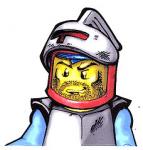
---------------------------------
The authentic image of God in the world is the image of crucified love -- nothing else. All the profusion of imagery in the Spiritual Canticle can only be explained and justified as the deployment of the 'hidden treasures' of this one image.
John carved crucifixes, but more than that, he drew a little oval sketch in Indian ink, about five. centimeters in diameter, to explain to one of his brethren the vision he had of the crucified in the chapel gallery. The sketch shows the hanging body with such staggering foreshortening that the technique alone 'presupposes long practice'.
The image only becomes comprehensible if we picture the body to ourselves hanging not vertically (as it usually does in representations of the cross) but downward by its hands and feet, with the crossbeams lying horizontally, downward into the darkness of God's night, the night of the world and the night of Hell.
It is in full downward flight that Christ appears to John; a stupendous vertical movement hurls him down, like a rock, the head first and straining the chest behind it, the neck vertical, the nape of the neck bent over, the arms distended and dislocated, the shoulder blades arched. The face is hidden, only the nape of the neck, the hair falling down in front of his face, the cranium, the upper part of the back, the hip, are visible. The lighting is violent, cast from above. A certain brutality produces this effect, while the lines of the drawing are supple and soft.
The work has two main features: the first appears to be imposed upon the artist, the other is his own contribution. What is imposed is the soaring vision, the apparition hurtling madly downward in the light, the divine body with specks of shadow, made of nerves rather than bones. What is imposed is to be seen in the arms composed of wounded, painfully swollen tissue, the suppleness of the narrow chest, which appears to be in flight from the unyielding wood, to be trying to detach itself and throw itself onto the ground. Under the force gravity the left wrist has been torn, and the nail has been reinserted into the swollen soft hand.
The heart bleeds in a long blackish stream on to the rigid chest ... John's own personal contribution is the sovereign allure of this vibrant sketch, full of intensity and at the same time almost relaxed, so delicately and with such quickness of touch has the artist worked. Artistic effectiveness is completely subordinated to the significance of the event. The impression almost of cruelty is revealed in an uncompromising anatomical representation (we must not forget that the young Juan de Yepes, at the age of twenty, was an orderly at the hospital ... of Medina del Campo). (Florisoone)
Florisoone reflects on the opportunities John might have had, at the time the sketch was drawn (1572-1577 in Avila), of seeing imitations of Italian originals in vertical perspective: Michelangelo's Last Judgment, which was imitated by Spanish artists, the early works of Tintoretto (El Greco only appears later). Elements of pictures, or of their copies, that John had seen may well have entered into his vision and its depiction, for 'God speaks the language of time and place'; 'yet in power of dramatic expression and in technical skill St John of the Cross surpassed the innovations of Michelangelo, Correggio, Tintoretto and El Greco, remarkable enough though they are'. (Florisoone)
----------------------------
http://praiseofglory.com/johncrossvonb.htm




No comments:
Post a Comment